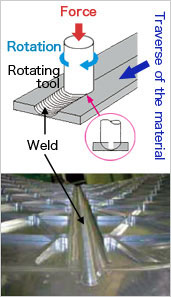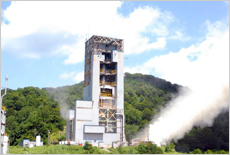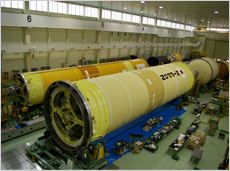

Friction-stir welding technology
To improve the launch reliability of the H-IIB, we have come up with many innovations. The diameter of the first-stage body has been extended from 4 meters to 5.2 meters. This means that the propellant tank's walls had to be thicker and stronger. H-IIA tanks are built with the conventional welding method, where the five cylinder pieces are joined together with repeatedly overlaid welds. But the H-IIB tank requires significantly more advanced welding to achieve the desired thickness. In addition, if an impurity such as an oxidized film is mistakenly mixed during welding, bubbles are formed, weakening the tank wall. When that happens, we have to remove the weld and repair it - an expensive and troublesome process. To mitigate this problem, we have used a different welding method: in friction-stir welding, a stir rod is rotated at the joint of aluminum sheets, using friction to heat the metal to about 500ºC, when it becomes soft. The softened sheets are then joined. Another advantage of friction-stir welding is that it can mechanized, so that quality is more stable and the production is faster and cheaper than conventional welding, which requires skilled craftsmanship.
Another development in H-IIB production is the shift from overseas procurement to domestic production of the dome-shaped front and rear mirror panels of the first-stage propellant tank. The panels are made from aluminum sheets of 5 meters in diameter, formed into shape while spinning. Although this spinning method is quite common in small-component manufacturing, the technology to shape such large and tough aluminum alloy panels was previously not available in Japan. Thanks to many years of R&D, MHI has now mastered the technique. It is to the great credit of MHI that we were able to acquire and perfect this technique.

Firing test at MHI's Tashiro Test Facility
It has been almost five years since the development of the H-IIB began. I think the collaboration between JAXA and MHI has been going very well. We are all very committed to our missions. When there is a problem, we are open to discussion, and work together to find the best solution. In case of a technological problem, we share our insights with MHI staff, rather than leaving it completely up to them to fix. We all have our sights set on the successful launch of the H-IIB.

H-IIB rocket in production (front)
We are currently doing development tests for the HTV's payload fairing, and at the same time manufacturing vehicles for the test flight of the H-IIB. In 2009, the test vehicle will be transferred to the Tanegashima Space Center, and in the spring, we will conduct firing tests of the first stage. The ground facilities have been modified for the H-IIB, so we will make us of all the facilities, including the propellant-supply system, to actually load propellant and follow the entire launch countdown procedure. This test will cap off the development of the H-IIB. In these firing tests, we will use the engines used in battleship firing tests at MHI's Tashiro Test Facility, which will subsequently be replaced with the actual launch engine. By early summer of 2009, after assembling four solid rocket boosters, we will carry out a comprehensive ground test using the actual test flight vehicle, in order to confirm functions, propellant loading, launch procedure and facilities. Using the actual launch vehicle is one of the new ways of achieving low cost and low risk.
With one more year until launch day, we will do our best to ensure success.
Related Link: H-IIB Launch Vehicle
Tomihisa Nakamura
H-IIB Project Manager, Space Transportation Mission Directorate, JAXA
Mr. Nakamura joined the National Space Development Agency of Japan (NASDA, now part of JAXA) in 1973. After serving as sub-manager of the H-IIA project team, he was appointed to his current position in August 2007.
H-IIB Project Manager, Space Transportation Mission Directorate, JAXA
Mr. Nakamura joined the National Space Development Agency of Japan (NASDA, now part of JAXA) in 1973. After serving as sub-manager of the H-IIA project team, he was appointed to his current position in August 2007.
The H-IIB Launches a New Rocket Era in Japan
H-IIB Launch Vehicle: Designed for World-Class Launch Capability
The Next Step in Japan's Space Development
HTV: An Indispensable Part of ISS Operations
H-IIB Launch Vehicle: Designed for World-Class Launch Capability
The Next Step in Japan's Space Development
HTV: An Indispensable Part of ISS Operations